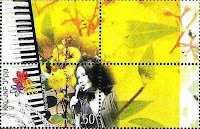"Jerusalem of Gold"

Naomi Shemer (1930-2004) - the most readily identified artist in the world of Israeli music following the establishment of the State. She wrote and composed hundreds of songs that became Israeli classics thanks to her wonderful integration of words and melodies. Her most famous song - "Jerusalem of Gold" - has become, in fact, a second "National Anthem" in Israel.
Jerusalem of Gold" (Yerushalayim Shel Zahav) was written by Naomi Shemer in 1967. The original song described the Jewish people's 2000-year longing to return to Jerusalem; Shemer added a final verse after the Six-Day War to celebrate Jerusalem's unification under Israeli control.
Naomi Shemer wrote the original song for the Israeli Music Festival on 15 May 1967, th e night after Israel's nineteenth Independence Day. She chose the then-unknown Shuli Nathan to sing the song. At that time, the Old City was under Jordanian rule; Jews had been barred from entering, and many holy sites had been desecrated. Only three weeks after the song was published, the Six-Day War broke out. The song was the battle cry and morale booster of the Israeli troops. Shemer even sang it for them before the war and festival, making them among the first in the world to hear it.
e night after Israel's nineteenth Independence Day. She chose the then-unknown Shuli Nathan to sing the song. At that time, the Old City was under Jordanian rule; Jews had been barred from entering, and many holy sites had been desecrated. Only three weeks after the song was published, the Six-Day War broke out. The song was the battle cry and morale booster of the Israeli troops. Shemer even sang it for them before the war and festival, making them among the first in the world to hear it.
Naomi Shemer wrote the original song for the Israeli Music Festival on 15 May 1967, th
 e night after Israel's nineteenth Independence Day. She chose the then-unknown Shuli Nathan to sing the song. At that time, the Old City was under Jordanian rule; Jews had been barred from entering, and many holy sites had been desecrated. Only three weeks after the song was published, the Six-Day War broke out. The song was the battle cry and morale booster of the Israeli troops. Shemer even sang it for them before the war and festival, making them among the first in the world to hear it.
e night after Israel's nineteenth Independence Day. She chose the then-unknown Shuli Nathan to sing the song. At that time, the Old City was under Jordanian rule; Jews had been barred from entering, and many holy sites had been desecrated. Only three weeks after the song was published, the Six-Day War broke out. The song was the battle cry and morale booster of the Israeli troops. Shemer even sang it for them before the war and festival, making them among the first in the world to hear it.On 7 June, the Israel Defense Forces captured the eastern part of Jerusalem and the Old City from the Jordanians. When Shemer heard the paratroopers singing "Jerusalem of Gold" at the Western Wall, she wrote a final verse, reversing the phrases of lamentation found in the second verse. The line about shofars sounding from the Temple Mount is a reference to an event that actually took place on 7 June.
The song has been translated loosely into many languages. It was also chosen as the "Song of the Year" in Israel in 1967. The song is the corps song of the Blue Stars Drum and Bugle Corps. The corps sings it before every competition.
The stamp above (block) features Naomi Shemer singing issued in 2004. Below is Shemer,part of a sheet of musician, composers, poets and singers.






